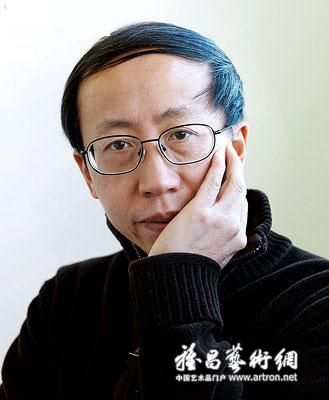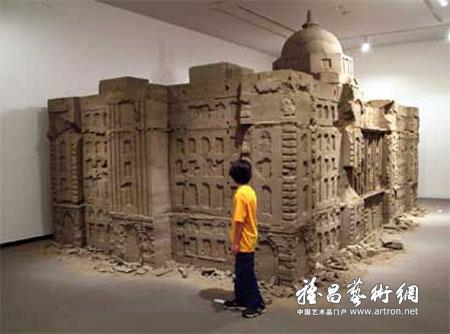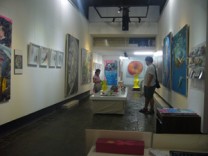"I always insist that the artist must be given carte blanche"-Interview to Huang Yongping
2011-04-15 11:33:10

Huang Yong Ping is a conceptual artist whose works combine Chinese traditions with current concerns. Born in Xiamen, south China, he emigrated to France in 1989. In the mid-1980s he was a leading proponent of the Xiamen Dada movement. His seminal work from this period, The History of Chinese Painting and the History of Modern Western Art Washed in the Washing Machine for Two Minutes, was exhibited at the landmark “China Avant-Garde” show in Beijing in 1989 which precipitated an invitation to display the piece at the “Magiciens de la Terre” show at the Pompidou in Paris, as well as Huang’s move to France.
After leaving China, Huang’s work developed from its Dadaist roots into huge, complex installations. His most controversial series, Bat Project I-IV, was made in response to an incident in 2001 when an American spy plane collided with a Chinese military aircraft over the South China Sea (p22). The series was withdrawn from shows in Shenzhen, Guangzhou and Beijing because of diplomatic jitters.
He represented France (with Jean-Pierre Bertrand) at the 1999 Venice Biennale and has had a string of recent exhibitions at major international venues including a travelling show co-organised by Astrup Fearnley Museum of Modern Art in Oslo and the Kunsthallen Brandts in Odense where it is now on view until 21 September; and a touring retrospective “The House of Oracles”, which debuted at the Walker Art Center in Minneapolis in 2005, travelled to Vancouver Art Gallery and closed at the Ullens Center for Contemporary Art in Beijing in June.

The artist’s first solo exhibition in the UK is now at the Barbican in London until 21 September. “Frolic” focuses on the Opium Wars between Britain and China in the 19th century and consists of a series of new works: oversized models of paraphernalia associated with opium production and consumption such as bowls and scales.
The Art Newspaper: Why did you become a Dadaist in the 1980s?
Huang Yong Ping: We emerged against the background of the ‘85 New Wave’ movement. What happened to the art world was that everyone was trying to obtain power and increase their influence. New Wave was about artists expressing their emotions. The Dadaists wanted to do something entirely different—not to acknowledge them, and to think in a different way.
TAN: You recently had a retrospective at the Ullens Center in Beijing. What was the reaction of visitors to your show?
HYP: The viewers’ reaction is not the main concern of the artist, and I left immediately after the opening ceremony, so I don’t know much about people’s responses.
TAN: The scale of your installations is huge and you use unorthodox materials, which makes your work difficult to sell. How do you survive as an artist?
HYP: The concept of size—large and small—is a relative one. I don’t think my works are particularly huge. If you compare them with nature, then they are really insignificant. My second point is that normally a large-scale installation would be sponsored or commissioned by a museum for a specific exhibition, and I would not be out of pocket for creating it. Whether the museum is able to store the work is not my concern. I don’t worry about that, and that does not affect my livelihood. I always insist that the artist must be given carte blanche.
Making art is different from the way businessmen produce their products. They have to invest money to produce and then sell the products to re-invest. But art is not about investing and selling. An artist has an idea, and by coincidence or luck, someone comes along to sponsor the work. Would I have had the same ideas had no one sponsored me? It doesn’t work like this. It so happens that someone is willing to support an artist’s creation. Therefore I never consider the size or the saleability of my works, or whether they are collectible. These are not my concerns.
TAN: What about the plane that you were going to exhibit in Guangzhou, which was withdrawn?
HYP: What happened in Guangzhou went back to 2002 in Shenzhen when I first exhibited in China. I participated in a Chinese sculpture exhibition as a French sculptor. The French Embassy in China believed that this work would not benefit the diplomatic relations of France, the US and China, and suggested that it be taken off display. Therefore it was censored. But the question of who censored it is rather complicated; in the end it was China’s Ministry of Culture that did not approve the exhibit. What happened in Guangzhou was a reaction to this incident. The cancellation was not from the museum. In China, museums come under the Cultural Bureau, which in turn is under the Ministry of Culture. And if the authority told them that they couldn’t show certain items, they wouldn’t dare to display them.
TAN: The market for Chinese contemporary art is largely geared towards foreign buyers. Some Chinese artists are creating production-line works for them. What do you think the dangers are in this?
HYP: Those who are greedy, whose appetites aren’t easily satisfied, and who are willing to be trapped in this, have to face the consequences. The media is responsible for it, because it is the media that has caused the hype. They publicise these works and emphasise the prices at which they sell. That’s the danger of it. Secondly, in today’s climate, there are plenty of works that are called art and look like art, but are not really art. This “fake art” confuses people. These works are not worth mentioning; so I think that the media should ignore them and not give them the publicity. By ignoring them they will die out naturally.
TAN: Do you think artists should boycott the Beijing Olympics?
HYP: In my view, the Olympic Games should be cancelled. Not simply the event in China, but the entire Games should end, because they are totally meaningless. The original spirit of the Olympics is already dead. They have become a political or economic tool and are being used. They should be replaced by something new. The format that we have at the moment is dead.
TAN: But what is your view about the artist’s role in all this? Should artists demonstrate against the wrongs of the government — for example, human rights abuses in Tibet?
HYP: I think the important thing is that artists should stay well away from authority…I mean from power, stay well away from it, no matter what form or appearance it takes. An artist’s attitude is not about taking part in demonstrations or protests, or to make his views on a certain issue known to the public. Rather, artists should instill their political views in their works. An artist should distance himself from power so that he can think independently.
TAN: What future projects would you like to be involved in?
HYP: I never plan. I never feel strongly about anything, not even that work [the plane that was censored].
TAN: It is now 20 years since you moved to France. Do you think you will ever return to live in China?
HYP: I didn’t intend to stay in France when I first arrived and now I have no plans to live in China.
Translated from Mandarin by Voice and Script International, London
Biography
Currently showing: Barbican Centre, London, until 21 September; Kunsthallen Brandts, Odense, Denmark until 21 September Born: 1954, Xiamen, China Education: Zhejiang Academy of Fine Arts Selected solo shows 2008: Ullens Center for Contemporary Art, Beijing; Astrup Fearnley Museum of Modern Art, Oslo 2007: Gladstone Gallery, New York 2006: Mass MoCA, North Adams 2005: Walker Art Center, Minneapolis Selected group shows, 2006: “China Power Station, Part 1” at the Serpentine Gallery, London; “La Force de l’art” at the Grand Palais, Paris 1999: “One Man, Nine Animals”, French Pavilion, 48th Venice Biennale

 黄琦
黄琦 测试用艺术
测试用艺术
